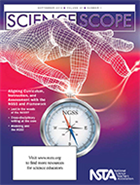Aligning curriculum, instruction, and assessment with the NGSS and Framework
By Mary Bigelow
Posted on 2013-09-23
 One of the big ideas from my teaching courses was “congruency”—an alignment of curriculum (What content and skills will you teach?), instruction (What learning activities will help students learn and use the content and skills?), and assessment (How will students demonstrate or show what they learned?). The featured articles in this month’s issue of Science Scope provide opportunities for teachers to learn more about how to align the Next Generation Science Standards (NGSS) with student learning opportunities. As the editor suggests, now is a good time to take this new vehicle on a “test drive.”
One of the big ideas from my teaching courses was “congruency”—an alignment of curriculum (What content and skills will you teach?), instruction (What learning activities will help students learn and use the content and skills?), and assessment (How will students demonstrate or show what they learned?). The featured articles in this month’s issue of Science Scope provide opportunities for teachers to learn more about how to align the Next Generation Science Standards (NGSS) with student learning opportunities. As the editor suggests, now is a good time to take this new vehicle on a “test drive.”
A question that is on the mind of most science teachers is “What will my school and I have to change to meet the expectations in the new standards?” The author of the guest editorial Conceptual Shifts in the NGSS: Opportunities and Challenges describes seven shifts in thinking and the challenges and opportunities that are evolving. The editorial also has advice about how to approach the decision makers in your district or school to move toward implementation.
If you’re looking for ways to incorporate writing in science (as noted in the Common Core State Standards), Cross-Disciplinary Writing: Scientific Argumentation, the Common Core, and the ADI Model describes the “Argument Driven Inquiry” (ADI) model that science teachers can use in student expository writing and argumentation. There are several graphics that describe the 8 stages of the model and their alignment with the CCSS. I suspect that many teachers already have students writing in class, and this model combines science, writing, and argumentation into a do-able, authentic process.
Similarly, English Language Arts and Science: A Shift Toward Student Success describes some of the commonalities between language arts and science: an understanding of vocabulary, questioning, making inferences, visualizing and connecting ideas, creating models, determining important ideas (comparing and contrasting), synthesizing information, and communicating. The authors show how language arts and science can be integrated in a topic about which students (and many adults) have misconceptions: the reasons for the seasons. The article includes an anticipation guide, informational text, vocabulary strategies and writing activities. [SciLinks: Seasons]
Developing and Using Models to Align with NGSS illustrates the complementary nature of disciplinary core ideas (DCI) and modeling. The authors suggest using the article to work with colleagues as a professional learning opportunity. The Earth-Sun-Moon system provides the context for this article. [SciLinks: Earth-Moon Connection, Moon Phases, Solar System]
The use of modeling continues with Incorporating Models Into Science Teaching to Meet the NGSS. The authors note that models serve four roles: data synthesis, representations of science ideas, substitutes for natural phenomena, and hypotheses and claims. They provides examples of these kinds of models and provide a chart of suggested activities and connections with the performance expectations of the NGSS. The article also includes suggestions for getting started with the use of models.
The fall is a great time to be outdoors. Rather than traditional scavenger hunts or collection activities, Modeling the Forest describes an investigation in which students collect tree data to model a single tree or a forested area. The article provides activities, student handouts, and background information. NGSS: Lost in the Woods describes an investigation of moss and lichen growth on trees as a way of ramping up a traditional activity into an extended investigation. [SciLinks: Forests, Autumn Leaves, Deforestation, Lichens, What Are Mosses?]
[Modeling is the theme for the September issue of The Science Teacher. Check it out for more on the topic.]
Staying on the topic of wood, Innovative Composite Research Modeled in the Middle School Classroom describes an engineering-focused activity in which students explore how composites (based on wood and wood products) can be designed to create materials with more desirable properties. Students were asked to develop a stronger wood-based product—a composite of baker’s dough and sawdust. The authors include a day-by-day lesson suggestion with examples of student handouts/data sheets.
Ken Roy’s safety columns appear in both Science Scope and The Science Teacher. Each journal has a different column, but this month has a direct connection. We often think of safety as the domain of chemistry and biology teachers, but this month Ken writes Earth Science Safety: It’s All in Your Form (in Science Scope) and Acknowledging Safety in Physics (in The Science Teacher). Both of his columns should be required reading (and NSTA members have access to both journals).
Disclaimer: The views expressed in this blog post are those of the author(s) and do not necessarily reflect the official position of the National Science Teaching Association (NSTA).


